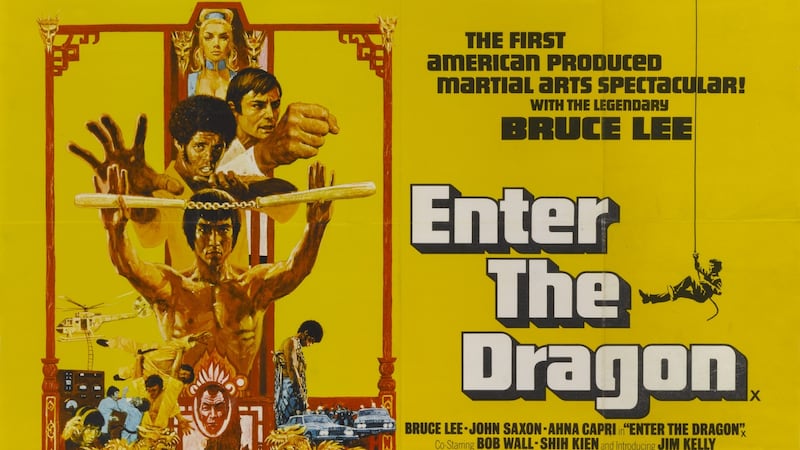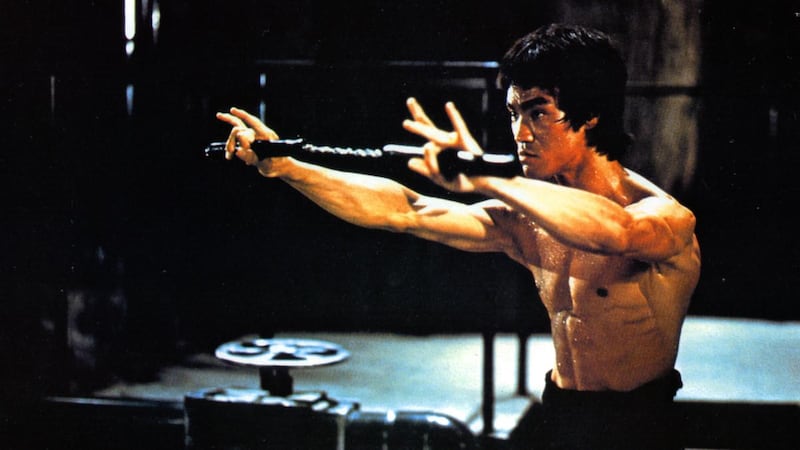Generally, the plotlines were weak and character development non-existent. The romantic interest for the lead man was zero and the dialogue poor to excruciating. But for Shaolin temple ass-whoopage, Bruce Lee’s films were off the charts.
Bruce Lee, with his screen presence and exquisite movement, was like nobody else. Reimagining the martial arts, Lee brought the western world probably the best kung fu yarn ever made in Enter The Dragon.
It was the last film Lee completed and like all the movies he ever shot, it was all about him. A lot of the footage was solely to bookend his transformative fight scenes. When Lee unbuttoned his black tunic to stand idiosyncratically twitching and striking poses you knew a bust-out was imminent. The entire film stopped to watch.
In a career crosscut by occasional nunchuck domination scenes, where two short batons linked by chain are whipped out from deep within his kung fu kick pants, Lee was a badass stylist famously too fast for the cameras to catch.
It was as much his shrieks and yowls during the fight sequences, his awesome bouts of orchestral knuckle-cracking, his Houdini-esque penchant for wriggling out of a shirt and his sinewy torso that could inflate to double its size while remaining pinched at the waist that made an unknown San Francisco-born Chinese-American actor into an enduring figure.
Kung fu hit Ireland in the 1970s with four films in which Lee played the lead role. The Big Boss (1971), Fist of Fury (1972), which was replete with anti-Japanese tropes, Way of the Dragon (1972) and Enter The Dragon (1973) brought Irish teenagers not just a brand new dangerous martial art, but magnetic Lee, a cage fighter before there was MMA. But with no tapping out.
All of the films seemed to arrive at about the same time as the US television series Kung Fu was airing. A martial arts western drama starring David Carradine, a white man in yellow face, it ran from 1972 to 1975 and in 1973 drew an audience of 28 million, becoming the number one US show.
Fighting style
Lee’s feline movement and fighting style, which became known as the “way of the intercepting fist”, also found a sobering path into the corridors of every Irish school. A schoolbag to the head noticeably gave way to silent aerial attacks from behind lockers and in schoolyards across the country.
Attempted swivel kicks to the throat rocketed. Duly accompanied by flapping hands and whimpering sounds, homemade nunchuks appeared. There was no end to the self-inflicted wounds.
Kids who could barely put their shoes on the right feet none the less trained their sixth sense with Lee’s mysterious “be like water” philosophy running through their heads. We watched Lee’s gravity-free two-finger press-ups and the nuclear 1-inch punch, and as no unwilling opponent, or cinder block for that matter, was safe from kung fu demolition.

But Enter The Dragon, which Lee completed before he died of a cerebral edema at 32 years old, was a Hollywood-treated version of the earlier slapstick, the absurdly dubbed Hong Kong flicks, which were all just vehicles to showcase his talent.
Typically, these films involved an evil gangster killing a family member of Lee’s character or Japanese arrivistas running a band of nerdy kung fu disciples out of their dojo before Lee turns them into a hot wet mess. The baddies, who, like the White Walkers in Game of Thrones, keep getting up, ultimately perish, often off camera to crashingly loud music, with a close-up of Lee’s enraged face ghoulishly accompanying the signature cartilage- and bone-cracking.
With recognisable American faces such as Roper, played by John Saxon, who was in The Last Samurai with Tom Cruise and From Dusk Till Dawn, a horror parody with George Clooney, Quentin Tarantino and Juliette Lewis, Enter The Dragon also marked a great improvement in the overall production values of the kung fu genre.
Film’s story
In the film Lee is sent as a spy to an offshore martial arts tournament hosted by a rogue-monk-turned-drug-lord called Han, who has a steel hand onto which he can snap on all kinds of kill fittings.
Conveniently, the arch-villain’s bodyguard O’Hara, who is responsible for the death of Lee’s sister, is also working on the island as an alpha male brute. Set against the rogue, Lee begins O’Hara’s humiliating end with a hat trick of snappy digs. That does the trick. The red Irish mist is instantaneous.
O’Hara then leaps in the air towards Lee, who repositions himself with his back on the ground and his leg straight up in the air. Inch perfect, he successfully skewers O’Hara’s testicles on his foot. Not at all walking straight, O’Hara then disgraces himself in front of the overlord, when he tries to ‘glass’ Lee with a broken bottle.
The fight scene eventually ends with Lee springing high and stomping O’Hara all the while buggering up his own face in a kind of visual projection of what is taking place down below around the thug’s head.
In the classic final fight scene, Lee faces Han and his deadly prosthetic hand in a hall full of mirrors. Lee accuses Han, not of purveying drugs but of offending his family and the Shaolin temple. Han throws him back an indifferent, unhinged smile while retooling his hand for carnage, adding four razor-sharp blades.
This is important, because before Lee perforates Han with a straight blast kick that sends him motoring through the air and into a spear that had been thrown through a panel earlier in the fight, Han has carved bloody slice marks across Lee’s face.
The three red slashes on one cheek and four on the other, with more slashes across Lee’s abdomen, has become one of the most distinctive pieces of ’70s iconography and arguably one of the most paradigmatic images in cinema.

This image, as well as those of Lee with his nunchuck stretched and arms straight out in front of him or in his yellow jumpsuit, which he wore in The Game of Death, a film he never got to finish, remain timeless kung fu piece. Uma Thurman's character Beatrix "Black Mamba" Kiddo paid homage to the jumpsuit in Tarantino's Kill Bill: Volume One.
But Lee never got to see or live his biggest success, as Enter The Dragon was released six days after his death. The film went on to gross an estimated US$350 million worldwide (equivalent to more than $1 billion today, adjusted for inflation), against a production budget of $850,000, making it the most profitable martial arts film.
‘Bruceploitation’
A "Bruceploitation" subgenre emerged after Lee's death, where film-makers from Hong Kong, Taiwan and South Korea cast Bruce Lee lookalike actors ("Lee-alikes") to star in imitation martial arts films, in order to exploit the genre's sudden international popularity.
Among such films were The Clones of Bruce Lee in 1980, Enter The Fat Dragon in 1978, Exit The Dragon, Enter The Tiger in 1976, The Dragon Lives Again in 1977 and Bruce Lee: The Man, The Myth in 1976.
MMA and the Ultimate Fighting Championship (UFC) can also trace their lineage back to Lee, who would have been 80 years old last November. His claim of simultaneously having no fighting style and every fighting style was tailor-made for cage fighting, which has some rules but not many and an array of styles.
Sugar Ray Leonard, a world boxing champion across five weight divisions, said he perfected his jab by watching Lee. Manny Pacquiao, the only eight division world champion in boxing, compared his fighting style to Lee, while Conor McGregor said he believed Lee would have been a champion in the UFC if he were to compete in the present day.
Former UFC champion Jon Jones has also cited Lee as an inspiration and is known for frequently using the oblique kick to the knee, a technique that was popularised by Lee, while American taekwondo pioneer Jhoon Goo Rhee learnt from Lee what Rhee called the "accupunch", which he incorporated into taekwondo.
Rhee later met Muhammad Ali in 1975, before his "Thrilla in Manila" fight with Joe Frazier, and taught it to him. The idea behind the non-telegraphic movement was to complete the strike inside human reaction time, which is about 0.25 seconds. Ali famously used it to knock out Richard Dunn in 1976.
Tarantino even wrote Lee into his 2019 movie Once Upon a Time in Hollywood. Lee, playing the character Kato from the US television series he worked on called The Green Hornet, fights on a set against a stuntman played by Brad Pitt.
In 2004, Enter The Dragon was selected for preservation in the US National Film Registry by the Library of Congress, having officially been deemed "culturally, historically, or aesthetically significant".
If that's too upscale there is alternative kung fu space available in which to kick back and admire Lee's elegantly delivered violence through the eyes of a teenager in the '70s. Enjoy evil getting licked in The Way of The Dragon as Lee takes out beefcake Chuck Norris and uses his kicks to put the house in roundhouse. All of it sprinkled with truly sleazy '70s charm.



















